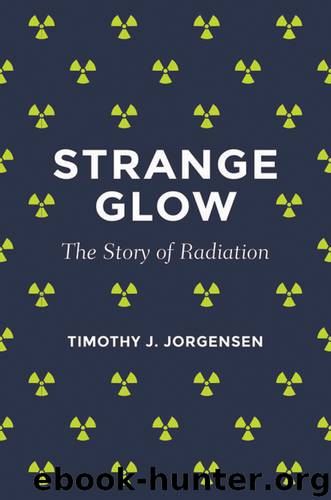Strange Glow by Jorgensen Timothy J.;

Author:Jorgensen, Timothy J.; [Jorgensen, Timothy J.;]
Language: eng
Format: epub
ISBN: 9780691178349
Publisher: Princeton University Press
Published: 2016-01-15T07:00:00+00:00
WORTH A THOUSAND WORDS
World War II disrupted research on the structure of DNA, and it wasn’t until the early 1950s that work resumed in earnest. One might expect that the Cavendish, with its expertise in x-ray crystallography, would have taken the lead, but two factors inhibited DNA research. First, the biologists at the Cavendish had already committed themselves to determining protein structures through x-ray crystallographic techniques. They were on the verge of great breakthroughs in that area; however, their focus was on the structures of myoglobin and hemoglobin, the body’s oxygen carriers, rather than on genes, since no proteins had yet been (or ever would be) shown to be genes. Solving these protein structures would ultimately earn the Cavendish more Nobel Prizes, but it certainly turned the laboratory’s attention away from genetics. Also, x-ray crystallographic studies of DNA structure were already underway by Maurice Wilkins (1916–2004) and his colleague Rosalind Franklin (1920–1958) at nearby Kings College, in London. British social protocol at the time called for scientists to respect each other’s research turf, so Cavendish scientists interested in DNA structure had to settle for persuading the Kings College scientists to reveal any data they might be willing to share.
It turned out that the only two Cavendish scientists with a passion for studying DNA’s structure were newcomers to the laboratory. These were an American postdoctoral fellow James Watson (born 1928), with a background in genetics, and a Cavendish graduate student Francis Crick (1916–2004), who had migrated into the study of biochemical structures from a prewar dabbling in physics. Both were passionate about the importance of DNA structure to understanding genetics, and both were frustrated at the lack of attention to this at the Cavendish and the slowness of the Kings College scientists in producing DNA crystallography data.
It didn’t help matters that Nobel Prize winner Linus Pauling was taking a strong interest in DNA. Pauling was one of the most brilliant protein structural chemists in the world and the discoverer of the alpha helix, a major structural feature of almost all proteins. In his work on the alpha helix, he had used a combined approach of model building and x-ray crystallography to correctly deduce the alpha helix’s structure, and there was no reason to believe that he would not be successful using that same approach for DNA. The fact that Pauling had actually written to Wilkins, asking to see some of his x-ray photographs of DNA, had sent a shiver down Wilkins’s spine. But Pauling was no more successful in getting a look at Wilkins’s films than Watson and Crick had been.
The reason why neither model building nor x-crystallography alone could produce a definitive answer was because in model building, there were just too many possible conformations to consider, with no clear way to discern which conformations might be correct. For x-ray crystallography, the data for stretched fibers were just not good enough to calculate all the bond angles required to define the exact structure. But the x-ray photographs were good enough to eliminate some theoretical models as being contrary to the x-ray reflection data.
Download
This site does not store any files on its server. We only index and link to content provided by other sites. Please contact the content providers to delete copyright contents if any and email us, we'll remove relevant links or contents immediately.
| Cell Biology | Developmental Biology |
| Entomology | Marine Biology |
| Microbiology | Molecular Biology |
| Biostatistics |
Sapiens: A Brief History of Humankind by Yuval Noah Harari(14037)
The Tidewater Tales by John Barth(12446)
Mastermind: How to Think Like Sherlock Holmes by Maria Konnikova(7001)
Do No Harm Stories of Life, Death and Brain Surgery by Henry Marsh(6726)
The Thirst by Nesbo Jo(6534)
Why We Sleep: Unlocking the Power of Sleep and Dreams by Matthew Walker(6423)
Life 3.0: Being Human in the Age of Artificial Intelligence by Tegmark Max(5246)
Sapiens by Yuval Noah Harari(5161)
The Longevity Diet by Valter Longo(4901)
The Body: A Guide for Occupants by Bill Bryson(4667)
The Rules Do Not Apply by Ariel Levy(4597)
The Immortal Life of Henrietta Lacks by Rebecca Skloot(4306)
Why We Sleep by Matthew Walker(4229)
Animal Frequency by Melissa Alvarez(4213)
The Hacking of the American Mind by Robert H. Lustig(4141)
Yoga Anatomy by Kaminoff Leslie(4141)
All Creatures Great and Small by James Herriot(4045)
Double Down (Diary of a Wimpy Kid Book 11) by Jeff Kinney(3997)
Barron's AP Biology by Goldberg M.S. Deborah T(3978)
